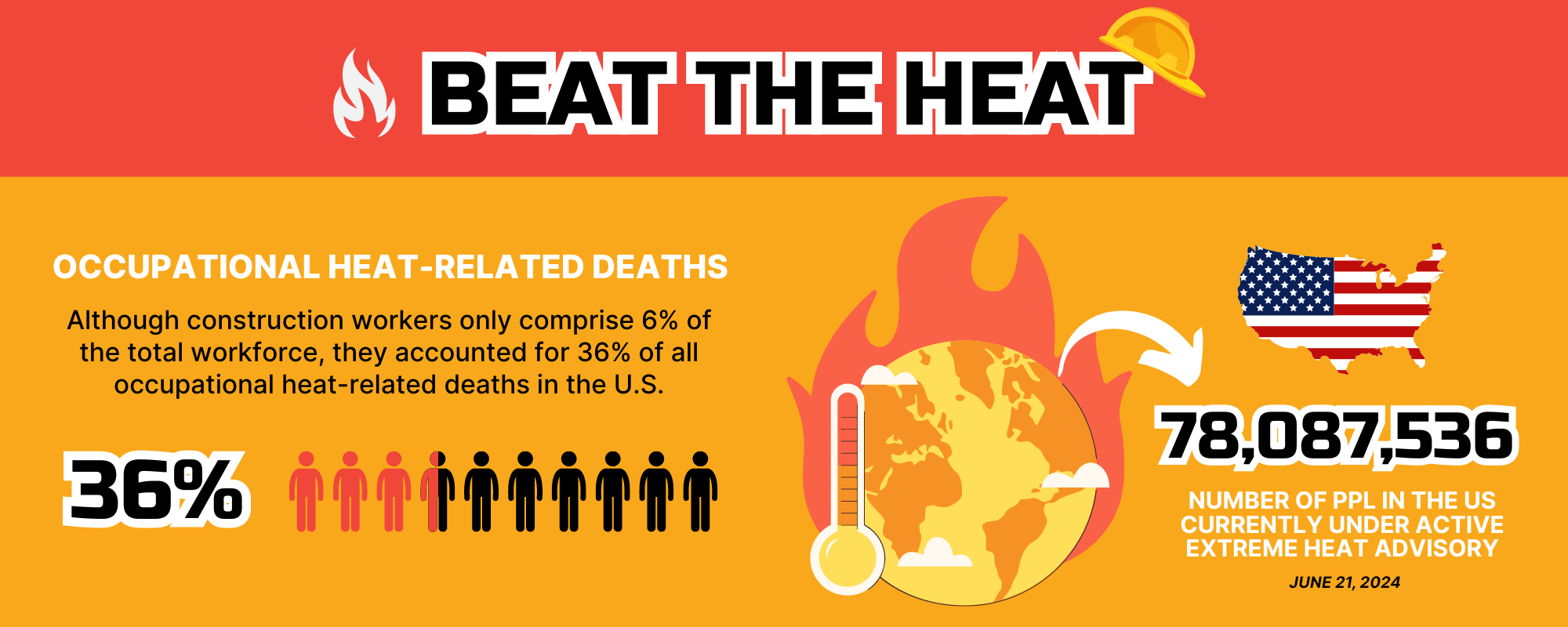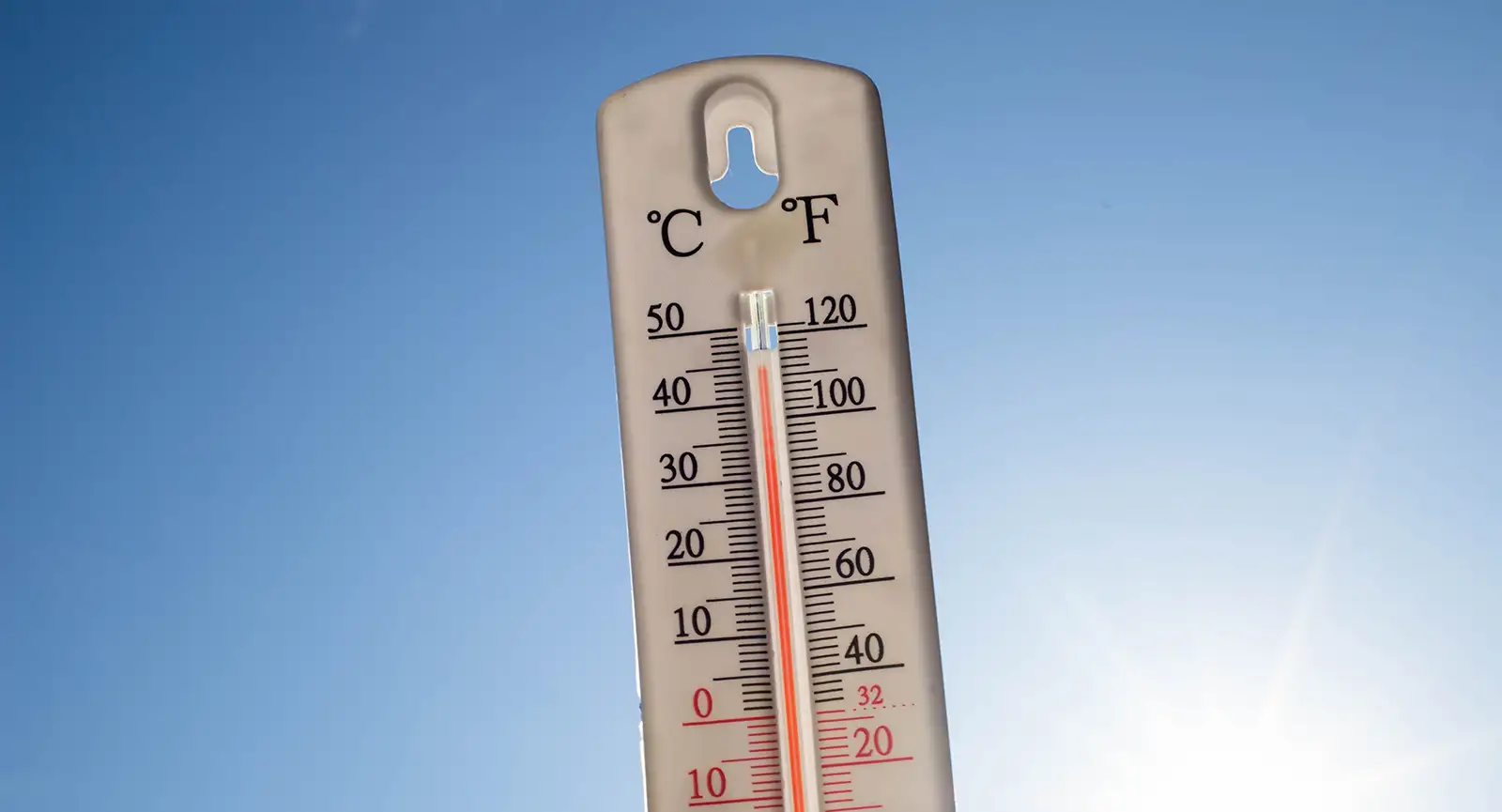Summertime is here, and to (very loosely) paraphrase the immortal words of Nelly, it’s getting hot out there (but we do NOT advise you to take off all your clothes). As temperatures rise this season, construction workers must prepare for the heat that can often put their health and safety at risk.

Whether you’re a seasoned construction worker or just starting, it’s crucial to know how to keep yourself safe and comfortable while working in hot and humid conditions. Fortunately, several tips and tricks can help you beat the heat on the construction site and prevent heat-related illnesses.
How to Identify Heat-Related Illness
Catching heat-related illnesses early makes a big difference because it means you can act quickly to stop things from getting worse. When you spot the signs sooner, you can cool down, rehydrate, and get medical help in time, which lowers the risk of serious problems like heat stroke or even death. It also keeps the workplace safer and more productive by tackling the issue before it leads to accidents or more health issues.
| Heat-Related Illness | Symptoms |
|---|---|
|
|
|
|
|
|
|
|
|
|
|
|
Does OSHA Have a Heat Standard?
Five states have enacted occupational heat standards: Washington, Oregon, California, Colorado, and Minnesota.
Five more have active legislation or are in the rulemaking stage: New York, New Jersey, Massachusetts, Maryland, and Utah.
Meanwhile, at the federal level, worker heat protection is in the early stages of development. Currently heat protection falls under the OSH Act’s General Duty Clause, a catch all that allows OSHA to inspect workplaces for recognized hazards not specifically regulated.
And while that sounds like it should serve as de facto heat protection, without a federally recognized standard it’s pretty toothless. Between 2017 and 2022, OSHA recorded 121 heat-related worker deaths – and this number is likely understated, as many heat-related deaths are often attributed to other workplace accidents or health conditions.
Read more: OSHA Heat Rules 2024: Protecting Workers from Heat Hazards
Causes of Heat Illness in Construction
Before we delve into our tried-and-true tips for beating the heat on the jobsite, it’s essential to understand the causes of heat illness in construction. Some of the most common reasons workers get sick while working in the heat include:
- Dehydration – not drinking enough fluids to stay hydrated
- Overexertion- pushing yourself beyond your limits
- High humidity – preventing sweat from evaporating efficiently (learn more about this)
These factors can lead to a variety of heat-related illnesses, ranging from mild heat cramps to severe heat stroke. Heat cramps are painful muscle contractions that can occur when you’re working in hot weather and sweating heavily. Heat exhaustion is a more serious condition that can cause symptoms such as dizziness, nausea, and fatigue. If left untreated, heat exhaustion can progress to heat stroke, which is a life-threatening medical emergency.
Who is the Most at Risk?
One of the most significant risk factors for heat illness in construction is the type of work being performed. Certain jobs, such as roofing or road construction, require workers to be exposed to direct sunlight for extended periods, increasing the risk of heat-related illnesses. Additionally, workers who are overweight, have a pre-existing medical condition, or are taking certain medications may be more susceptible to heat illness.
It’s important to note that heat illness doesn’t just affect workers during the summer months. Even in cooler weather, workers can still be at risk if they’re working in a hot environment, such as a boiler room or near a furnace.
What Can You Do to Combat Heat Illness?
Employers can take steps to prevent heat illness by providing workers with plenty of water and rest breaks, scheduling work during the cooler parts of the day, and implementing a heat illness prevention program.
Workers can also protect themselves by wearing lightweight, breathable clothing and taking frequent breaks in a shaded or air-conditioned area.
By understanding the causes of heat illness and taking steps to prevent it, workers can stay safe and healthy while working in hot weather conditions.
5 Tips for How to Stay Cool While Working Construction
1. Stay Hydrated
If you are working in a hot, dry environment, staying hydrated is essential. Be sure to drink water frequently, especially during breaks. In fact, it’s recommended that you drink at least 8 ounces of water every 20 minutes to keep your body hydrated. (If you, like me, find volume recommendations in ounces confusing, verging on useless, think of about three quarters of a bottle of beer.)
It’s easy to become dehydrated quickly when you’re sweating profusely, so make sure to drink water frequently throughout the day. You can also drink sports drinks that contain electrolytes to help replenish the minerals lost through sweating. Dehydration can lead to fatigue, dizziness, and even heat stroke, which can be life-threatening.
2. Take Frequent Breaks
It’s essential to take frequent breaks in a shaded or air-conditioned area to cool down. When you take a break, try to sit or lie down to allow your body to rest and recover. This will help you avoid overheating and exhaustion.
3. Wear Protective Clothing
Wearing loose, lightweight clothing that allows air to circulate around your body is crucial in hot conditions. Clothing made from breathable fabrics like cotton or linen can help keep you cool and comfortable. Additionally, wearing a hat or a bandana can protect your head and face from the sun.
Wearing light-colored, breathable clothing can help reflect the sun’s rays and keep you cooler. Dark colors, on the other hand, absorb heat and can make you feel hotter.
4. Use Personal Cooling Devices
Personal cooling devices like fans or cooling vests can help regulate your body temperature and keep you cool. A fan can help circulate air around your body, while a cooling vest can help lower your body temperature by several degrees.
5. Avoid the Hottest Parts of the Day
Try to schedule your workday to avoid the hottest parts of the day, typically between 10 a.m. and 4 p.m. If possible, start work earlier in the morning or later in the afternoon when the temperatures are cooler. This can help you avoid the worst of the heat and keep you safe.
Bonus: Sunscreen
While applying sunscreen won’t help you stay cool, it’ll protect you from skin damage. So consider this a bonus tip for the hot weather! Even if you’re working in the shade, the sun’s rays can still reach you and cause sunburn or skin cancer over time. Look for a broad-spectrum sunscreen with an SPF of at least 30 and apply it liberally to all exposed skin.
Listen to Your Body
By following these tips, you can stay comfortable and safe while working in dry and humid conditions. Remember to take care of your body and listen to its signals. If you feel dizzy, lightheaded, or nauseous, take a break and seek medical attention if necessary. Stay safe and have a productive summer!
Why Do Humid Days Feel So Much Worse?
Do you hate when people say “it’s not the heat, it’s the humidity”? Yeah, us too. But also… they’re right. Time for a quick science lesson.
Your body cools off by sweating, wicking heat from your body and beading moisture on the surface of your skin to evaporate into the air. But if the air is already full of moisture (aka humidity) that impedes evaporation, the sweat remains on your skin (and you remain hot).

High humidity levels can make it difficult for your body to cool off, which can lead to dehydration, heat exhaustion, and even heat stroke. Therefore, it’s essential to take precautions to keep yourself safe and comfortable while working in hot and humid conditions.
